International Destinations Management Report: A Comparative Analysis
VerifiedAdded on 2022/09/15
|13
|3554
|19
Report
AI Summary
This report provides a comparative analysis of international destination management, focusing on Singapore and Dubai. It explores their strategic interventions, marketing campaigns, and operational approaches to gain a competitive edge in the global tourism industry. The report examines the commonalities and differences between the two destinations, highlighting their respective strengths and weaknesses, such as Dubai's focus on low taxes and architectural marvels versus Singapore's emphasis on green technology and quality of life. It discusses the role of marketing in destination development, analyzing how both cities employ promotional campaigns and smart technologies to meet consumer expectations and address complex tasks. The report also addresses real-world issues and challenges faced by these destinations, offering insights into sustainable development and strategic management approaches to maximize the benefits of tourism while minimizing its negative impacts. Furthermore, the report details approaches and techniques for meeting requirements of complex tasks, including sustainable development and systems thinking.
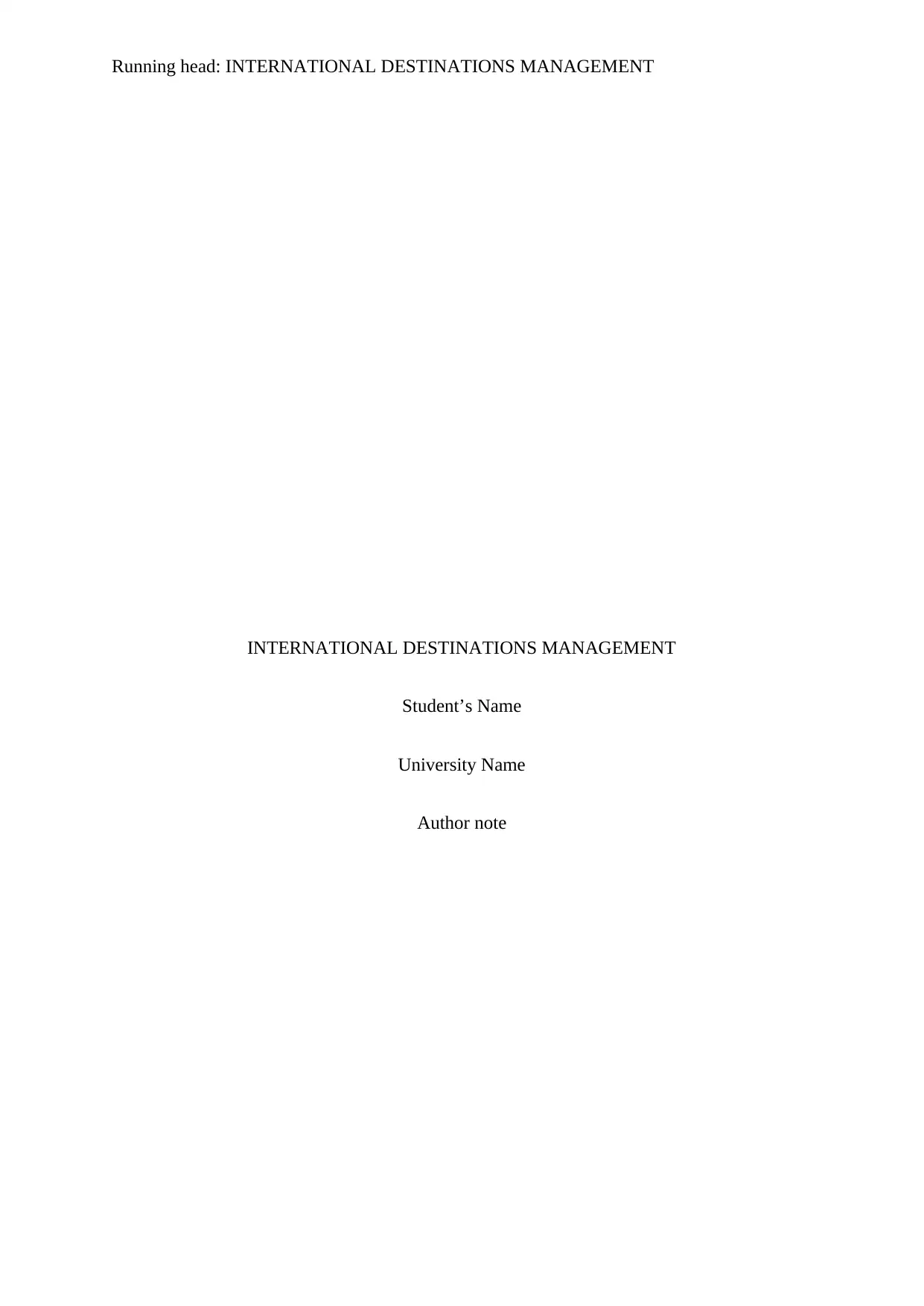
Running head: INTERNATIONAL DESTINATIONS MANAGEMENT
INTERNATIONAL DESTINATIONS MANAGEMENT
Student’s Name
University Name
Author note
INTERNATIONAL DESTINATIONS MANAGEMENT
Student’s Name
University Name
Author note
Paraphrase This Document
Need a fresh take? Get an instant paraphrase of this document with our AI Paraphraser
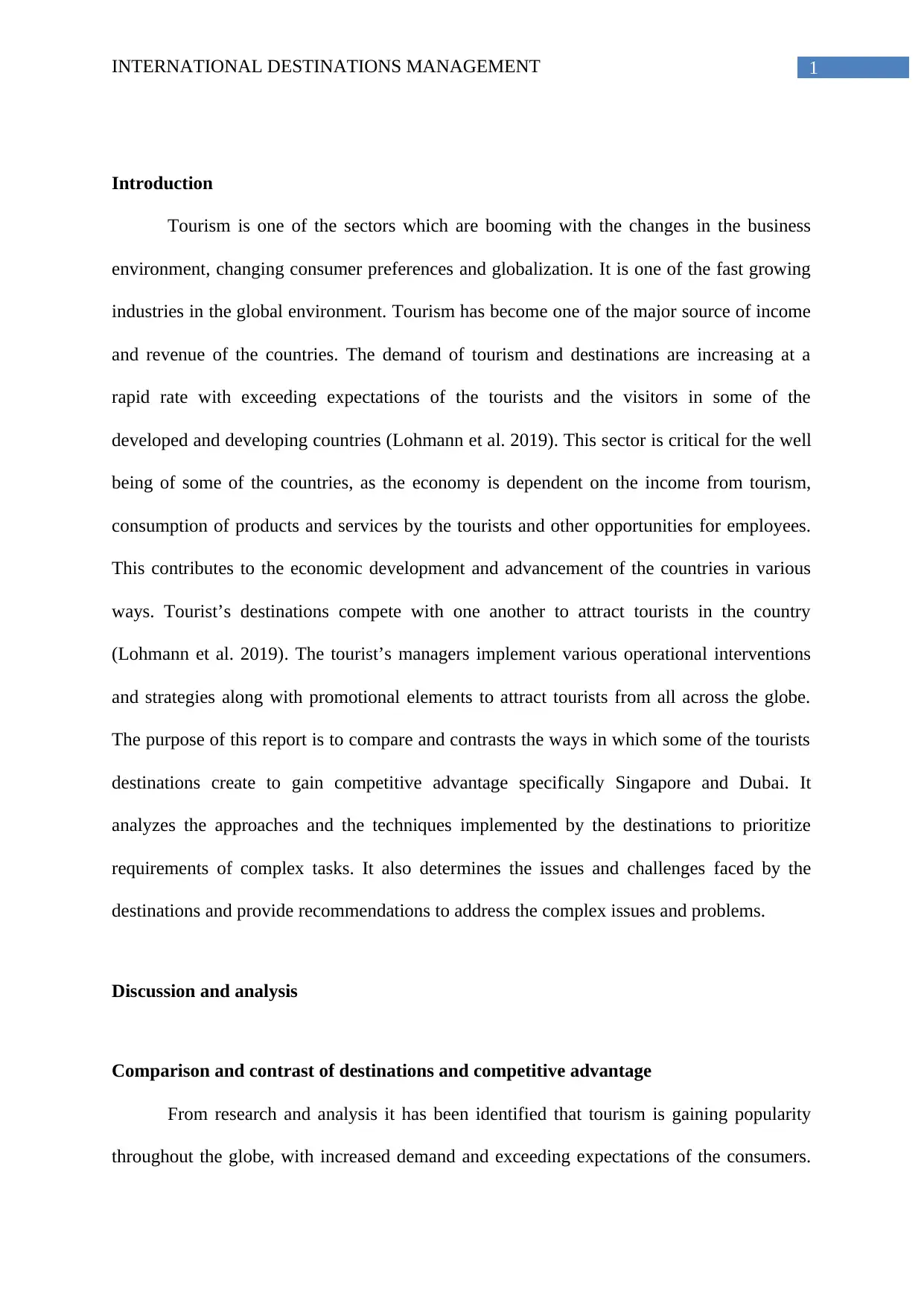
1INTERNATIONAL DESTINATIONS MANAGEMENT
Introduction
Tourism is one of the sectors which are booming with the changes in the business
environment, changing consumer preferences and globalization. It is one of the fast growing
industries in the global environment. Tourism has become one of the major source of income
and revenue of the countries. The demand of tourism and destinations are increasing at a
rapid rate with exceeding expectations of the tourists and the visitors in some of the
developed and developing countries (Lohmann et al. 2019). This sector is critical for the well
being of some of the countries, as the economy is dependent on the income from tourism,
consumption of products and services by the tourists and other opportunities for employees.
This contributes to the economic development and advancement of the countries in various
ways. Tourist’s destinations compete with one another to attract tourists in the country
(Lohmann et al. 2019). The tourist’s managers implement various operational interventions
and strategies along with promotional elements to attract tourists from all across the globe.
The purpose of this report is to compare and contrasts the ways in which some of the tourists
destinations create to gain competitive advantage specifically Singapore and Dubai. It
analyzes the approaches and the techniques implemented by the destinations to prioritize
requirements of complex tasks. It also determines the issues and challenges faced by the
destinations and provide recommendations to address the complex issues and problems.
Discussion and analysis
Comparison and contrast of destinations and competitive advantage
From research and analysis it has been identified that tourism is gaining popularity
throughout the globe, with increased demand and exceeding expectations of the consumers.
Introduction
Tourism is one of the sectors which are booming with the changes in the business
environment, changing consumer preferences and globalization. It is one of the fast growing
industries in the global environment. Tourism has become one of the major source of income
and revenue of the countries. The demand of tourism and destinations are increasing at a
rapid rate with exceeding expectations of the tourists and the visitors in some of the
developed and developing countries (Lohmann et al. 2019). This sector is critical for the well
being of some of the countries, as the economy is dependent on the income from tourism,
consumption of products and services by the tourists and other opportunities for employees.
This contributes to the economic development and advancement of the countries in various
ways. Tourist’s destinations compete with one another to attract tourists in the country
(Lohmann et al. 2019). The tourist’s managers implement various operational interventions
and strategies along with promotional elements to attract tourists from all across the globe.
The purpose of this report is to compare and contrasts the ways in which some of the tourists
destinations create to gain competitive advantage specifically Singapore and Dubai. It
analyzes the approaches and the techniques implemented by the destinations to prioritize
requirements of complex tasks. It also determines the issues and challenges faced by the
destinations and provide recommendations to address the complex issues and problems.
Discussion and analysis
Comparison and contrast of destinations and competitive advantage
From research and analysis it has been identified that tourism is gaining popularity
throughout the globe, with increased demand and exceeding expectations of the consumers.
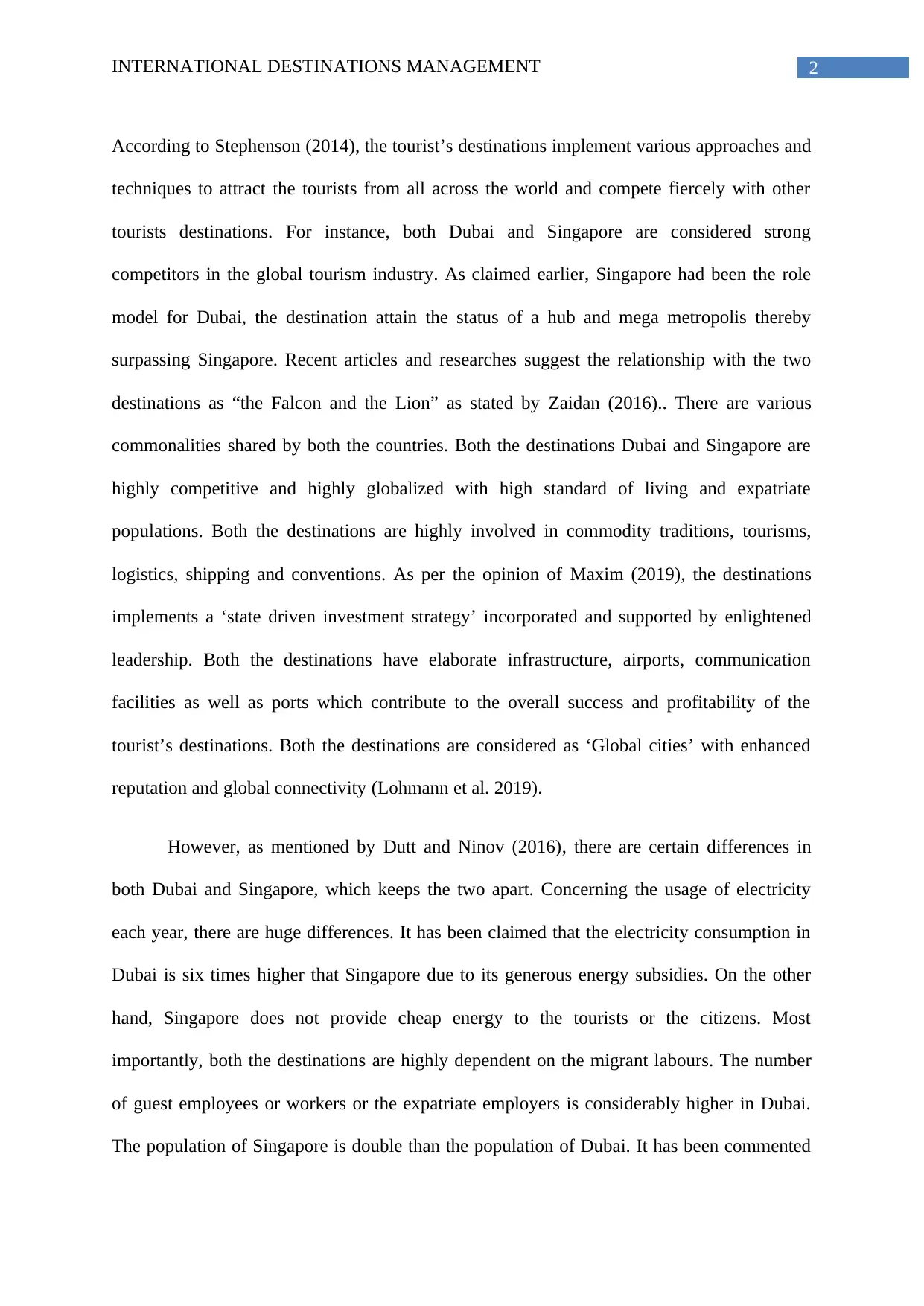
2INTERNATIONAL DESTINATIONS MANAGEMENT
According to Stephenson (2014), the tourist’s destinations implement various approaches and
techniques to attract the tourists from all across the world and compete fiercely with other
tourists destinations. For instance, both Dubai and Singapore are considered strong
competitors in the global tourism industry. As claimed earlier, Singapore had been the role
model for Dubai, the destination attain the status of a hub and mega metropolis thereby
surpassing Singapore. Recent articles and researches suggest the relationship with the two
destinations as “the Falcon and the Lion” as stated by Zaidan (2016).. There are various
commonalities shared by both the countries. Both the destinations Dubai and Singapore are
highly competitive and highly globalized with high standard of living and expatriate
populations. Both the destinations are highly involved in commodity traditions, tourisms,
logistics, shipping and conventions. As per the opinion of Maxim (2019), the destinations
implements a ‘state driven investment strategy’ incorporated and supported by enlightened
leadership. Both the destinations have elaborate infrastructure, airports, communication
facilities as well as ports which contribute to the overall success and profitability of the
tourist’s destinations. Both the destinations are considered as ‘Global cities’ with enhanced
reputation and global connectivity (Lohmann et al. 2019).
However, as mentioned by Dutt and Ninov (2016), there are certain differences in
both Dubai and Singapore, which keeps the two apart. Concerning the usage of electricity
each year, there are huge differences. It has been claimed that the electricity consumption in
Dubai is six times higher that Singapore due to its generous energy subsidies. On the other
hand, Singapore does not provide cheap energy to the tourists or the citizens. Most
importantly, both the destinations are highly dependent on the migrant labours. The number
of guest employees or workers or the expatriate employers is considerably higher in Dubai.
The population of Singapore is double than the population of Dubai. It has been commented
According to Stephenson (2014), the tourist’s destinations implement various approaches and
techniques to attract the tourists from all across the world and compete fiercely with other
tourists destinations. For instance, both Dubai and Singapore are considered strong
competitors in the global tourism industry. As claimed earlier, Singapore had been the role
model for Dubai, the destination attain the status of a hub and mega metropolis thereby
surpassing Singapore. Recent articles and researches suggest the relationship with the two
destinations as “the Falcon and the Lion” as stated by Zaidan (2016).. There are various
commonalities shared by both the countries. Both the destinations Dubai and Singapore are
highly competitive and highly globalized with high standard of living and expatriate
populations. Both the destinations are highly involved in commodity traditions, tourisms,
logistics, shipping and conventions. As per the opinion of Maxim (2019), the destinations
implements a ‘state driven investment strategy’ incorporated and supported by enlightened
leadership. Both the destinations have elaborate infrastructure, airports, communication
facilities as well as ports which contribute to the overall success and profitability of the
tourist’s destinations. Both the destinations are considered as ‘Global cities’ with enhanced
reputation and global connectivity (Lohmann et al. 2019).
However, as mentioned by Dutt and Ninov (2016), there are certain differences in
both Dubai and Singapore, which keeps the two apart. Concerning the usage of electricity
each year, there are huge differences. It has been claimed that the electricity consumption in
Dubai is six times higher that Singapore due to its generous energy subsidies. On the other
hand, Singapore does not provide cheap energy to the tourists or the citizens. Most
importantly, both the destinations are highly dependent on the migrant labours. The number
of guest employees or workers or the expatriate employers is considerably higher in Dubai.
The population of Singapore is double than the population of Dubai. It has been commented
⊘ This is a preview!⊘
Do you want full access?
Subscribe today to unlock all pages.

Trusted by 1+ million students worldwide
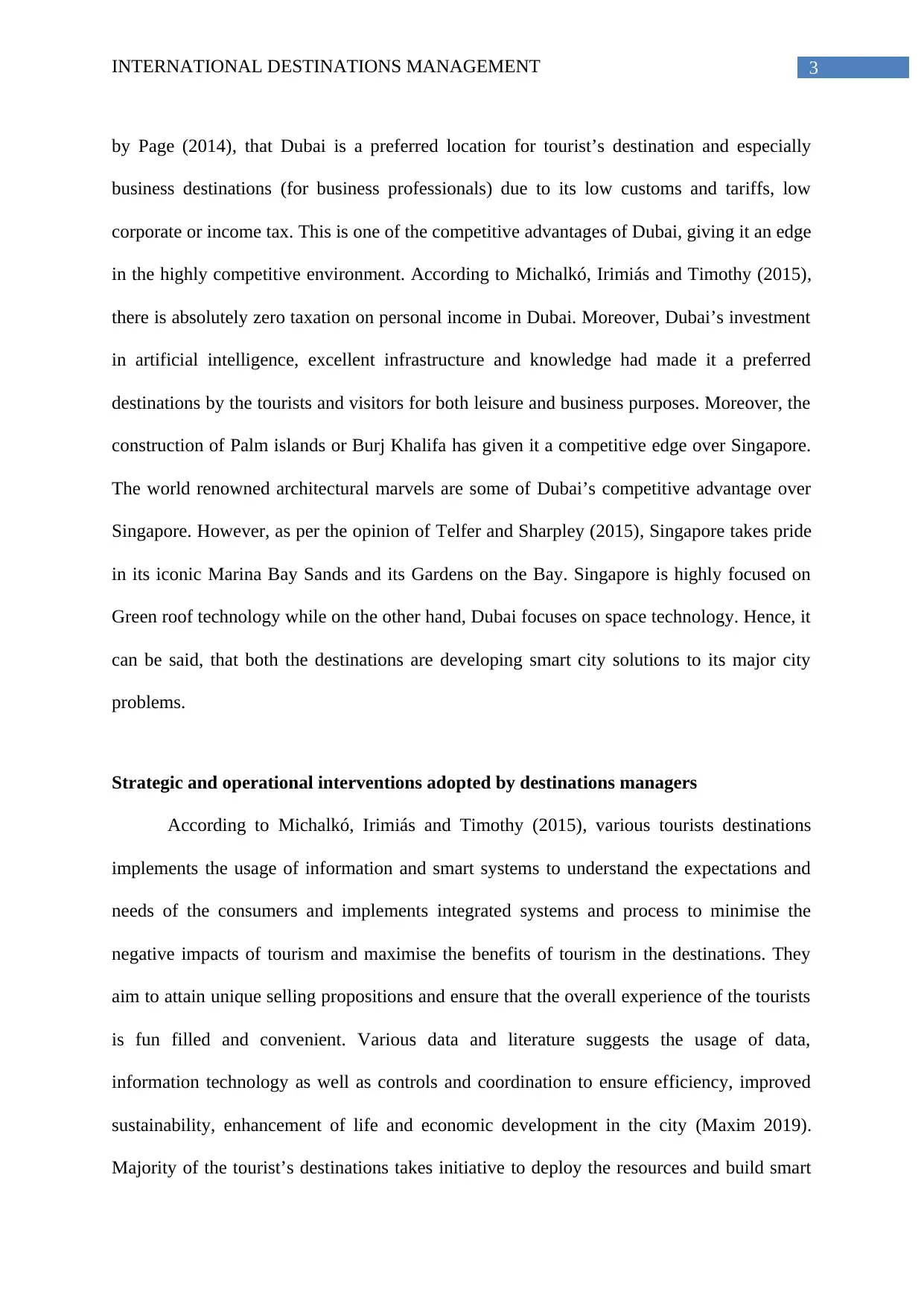
3INTERNATIONAL DESTINATIONS MANAGEMENT
by Page (2014), that Dubai is a preferred location for tourist’s destination and especially
business destinations (for business professionals) due to its low customs and tariffs, low
corporate or income tax. This is one of the competitive advantages of Dubai, giving it an edge
in the highly competitive environment. According to Michalkó, Irimiás and Timothy (2015),
there is absolutely zero taxation on personal income in Dubai. Moreover, Dubai’s investment
in artificial intelligence, excellent infrastructure and knowledge had made it a preferred
destinations by the tourists and visitors for both leisure and business purposes. Moreover, the
construction of Palm islands or Burj Khalifa has given it a competitive edge over Singapore.
The world renowned architectural marvels are some of Dubai’s competitive advantage over
Singapore. However, as per the opinion of Telfer and Sharpley (2015), Singapore takes pride
in its iconic Marina Bay Sands and its Gardens on the Bay. Singapore is highly focused on
Green roof technology while on the other hand, Dubai focuses on space technology. Hence, it
can be said, that both the destinations are developing smart city solutions to its major city
problems.
Strategic and operational interventions adopted by destinations managers
According to Michalkó, Irimiás and Timothy (2015), various tourists destinations
implements the usage of information and smart systems to understand the expectations and
needs of the consumers and implements integrated systems and process to minimise the
negative impacts of tourism and maximise the benefits of tourism in the destinations. They
aim to attain unique selling propositions and ensure that the overall experience of the tourists
is fun filled and convenient. Various data and literature suggests the usage of data,
information technology as well as controls and coordination to ensure efficiency, improved
sustainability, enhancement of life and economic development in the city (Maxim 2019).
Majority of the tourist’s destinations takes initiative to deploy the resources and build smart
by Page (2014), that Dubai is a preferred location for tourist’s destination and especially
business destinations (for business professionals) due to its low customs and tariffs, low
corporate or income tax. This is one of the competitive advantages of Dubai, giving it an edge
in the highly competitive environment. According to Michalkó, Irimiás and Timothy (2015),
there is absolutely zero taxation on personal income in Dubai. Moreover, Dubai’s investment
in artificial intelligence, excellent infrastructure and knowledge had made it a preferred
destinations by the tourists and visitors for both leisure and business purposes. Moreover, the
construction of Palm islands or Burj Khalifa has given it a competitive edge over Singapore.
The world renowned architectural marvels are some of Dubai’s competitive advantage over
Singapore. However, as per the opinion of Telfer and Sharpley (2015), Singapore takes pride
in its iconic Marina Bay Sands and its Gardens on the Bay. Singapore is highly focused on
Green roof technology while on the other hand, Dubai focuses on space technology. Hence, it
can be said, that both the destinations are developing smart city solutions to its major city
problems.
Strategic and operational interventions adopted by destinations managers
According to Michalkó, Irimiás and Timothy (2015), various tourists destinations
implements the usage of information and smart systems to understand the expectations and
needs of the consumers and implements integrated systems and process to minimise the
negative impacts of tourism and maximise the benefits of tourism in the destinations. They
aim to attain unique selling propositions and ensure that the overall experience of the tourists
is fun filled and convenient. Various data and literature suggests the usage of data,
information technology as well as controls and coordination to ensure efficiency, improved
sustainability, enhancement of life and economic development in the city (Maxim 2019).
Majority of the tourist’s destinations takes initiative to deploy the resources and build smart
Paraphrase This Document
Need a fresh take? Get an instant paraphrase of this document with our AI Paraphraser
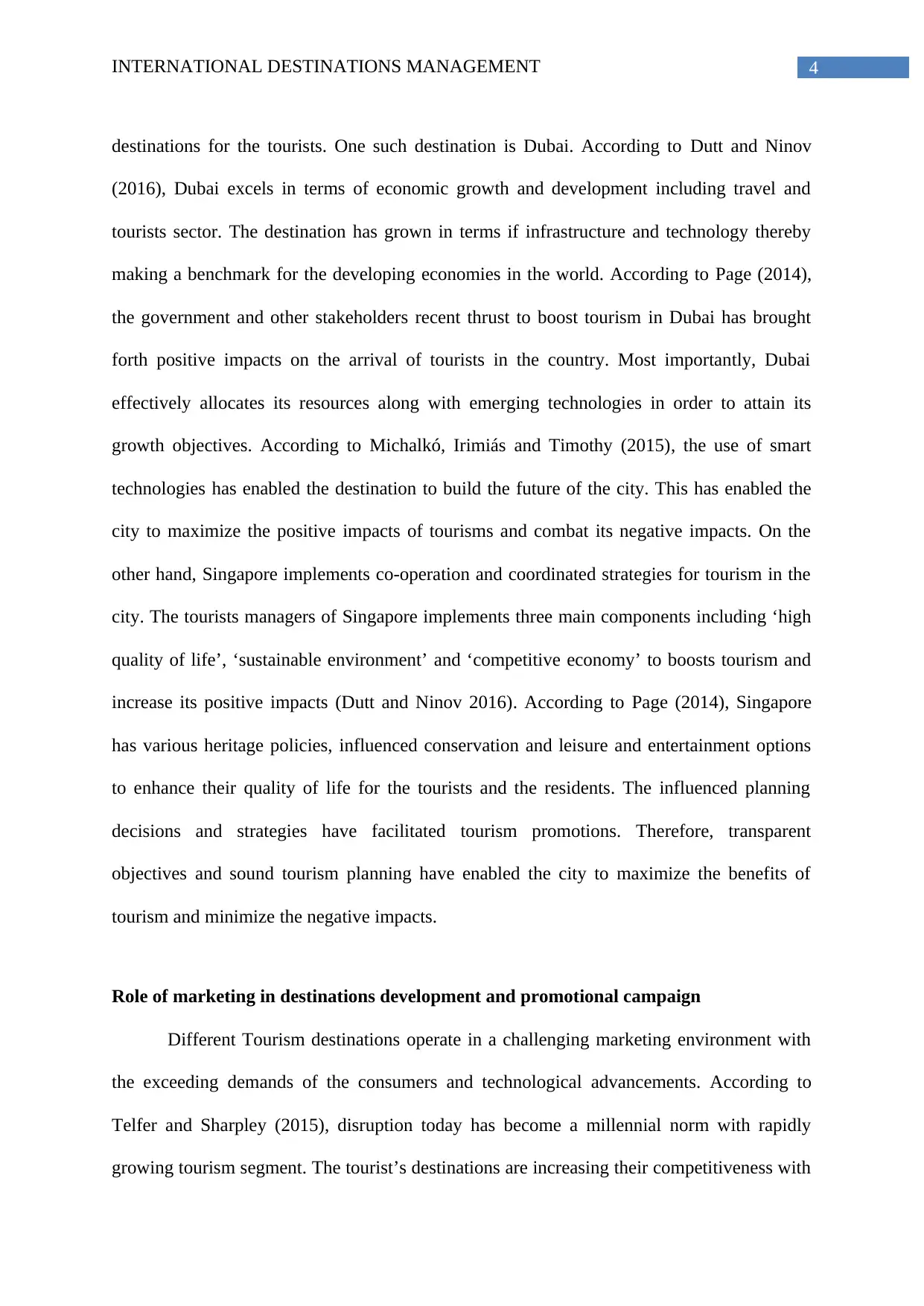
4INTERNATIONAL DESTINATIONS MANAGEMENT
destinations for the tourists. One such destination is Dubai. According to Dutt and Ninov
(2016), Dubai excels in terms of economic growth and development including travel and
tourists sector. The destination has grown in terms if infrastructure and technology thereby
making a benchmark for the developing economies in the world. According to Page (2014),
the government and other stakeholders recent thrust to boost tourism in Dubai has brought
forth positive impacts on the arrival of tourists in the country. Most importantly, Dubai
effectively allocates its resources along with emerging technologies in order to attain its
growth objectives. According to Michalkó, Irimiás and Timothy (2015), the use of smart
technologies has enabled the destination to build the future of the city. This has enabled the
city to maximize the positive impacts of tourisms and combat its negative impacts. On the
other hand, Singapore implements co-operation and coordinated strategies for tourism in the
city. The tourists managers of Singapore implements three main components including ‘high
quality of life’, ‘sustainable environment’ and ‘competitive economy’ to boosts tourism and
increase its positive impacts (Dutt and Ninov 2016). According to Page (2014), Singapore
has various heritage policies, influenced conservation and leisure and entertainment options
to enhance their quality of life for the tourists and the residents. The influenced planning
decisions and strategies have facilitated tourism promotions. Therefore, transparent
objectives and sound tourism planning have enabled the city to maximize the benefits of
tourism and minimize the negative impacts.
Role of marketing in destinations development and promotional campaign
Different Tourism destinations operate in a challenging marketing environment with
the exceeding demands of the consumers and technological advancements. According to
Telfer and Sharpley (2015), disruption today has become a millennial norm with rapidly
growing tourism segment. The tourist’s destinations are increasing their competitiveness with
destinations for the tourists. One such destination is Dubai. According to Dutt and Ninov
(2016), Dubai excels in terms of economic growth and development including travel and
tourists sector. The destination has grown in terms if infrastructure and technology thereby
making a benchmark for the developing economies in the world. According to Page (2014),
the government and other stakeholders recent thrust to boost tourism in Dubai has brought
forth positive impacts on the arrival of tourists in the country. Most importantly, Dubai
effectively allocates its resources along with emerging technologies in order to attain its
growth objectives. According to Michalkó, Irimiás and Timothy (2015), the use of smart
technologies has enabled the destination to build the future of the city. This has enabled the
city to maximize the positive impacts of tourisms and combat its negative impacts. On the
other hand, Singapore implements co-operation and coordinated strategies for tourism in the
city. The tourists managers of Singapore implements three main components including ‘high
quality of life’, ‘sustainable environment’ and ‘competitive economy’ to boosts tourism and
increase its positive impacts (Dutt and Ninov 2016). According to Page (2014), Singapore
has various heritage policies, influenced conservation and leisure and entertainment options
to enhance their quality of life for the tourists and the residents. The influenced planning
decisions and strategies have facilitated tourism promotions. Therefore, transparent
objectives and sound tourism planning have enabled the city to maximize the benefits of
tourism and minimize the negative impacts.
Role of marketing in destinations development and promotional campaign
Different Tourism destinations operate in a challenging marketing environment with
the exceeding demands of the consumers and technological advancements. According to
Telfer and Sharpley (2015), disruption today has become a millennial norm with rapidly
growing tourism segment. The tourist’s destinations are increasing their competitiveness with
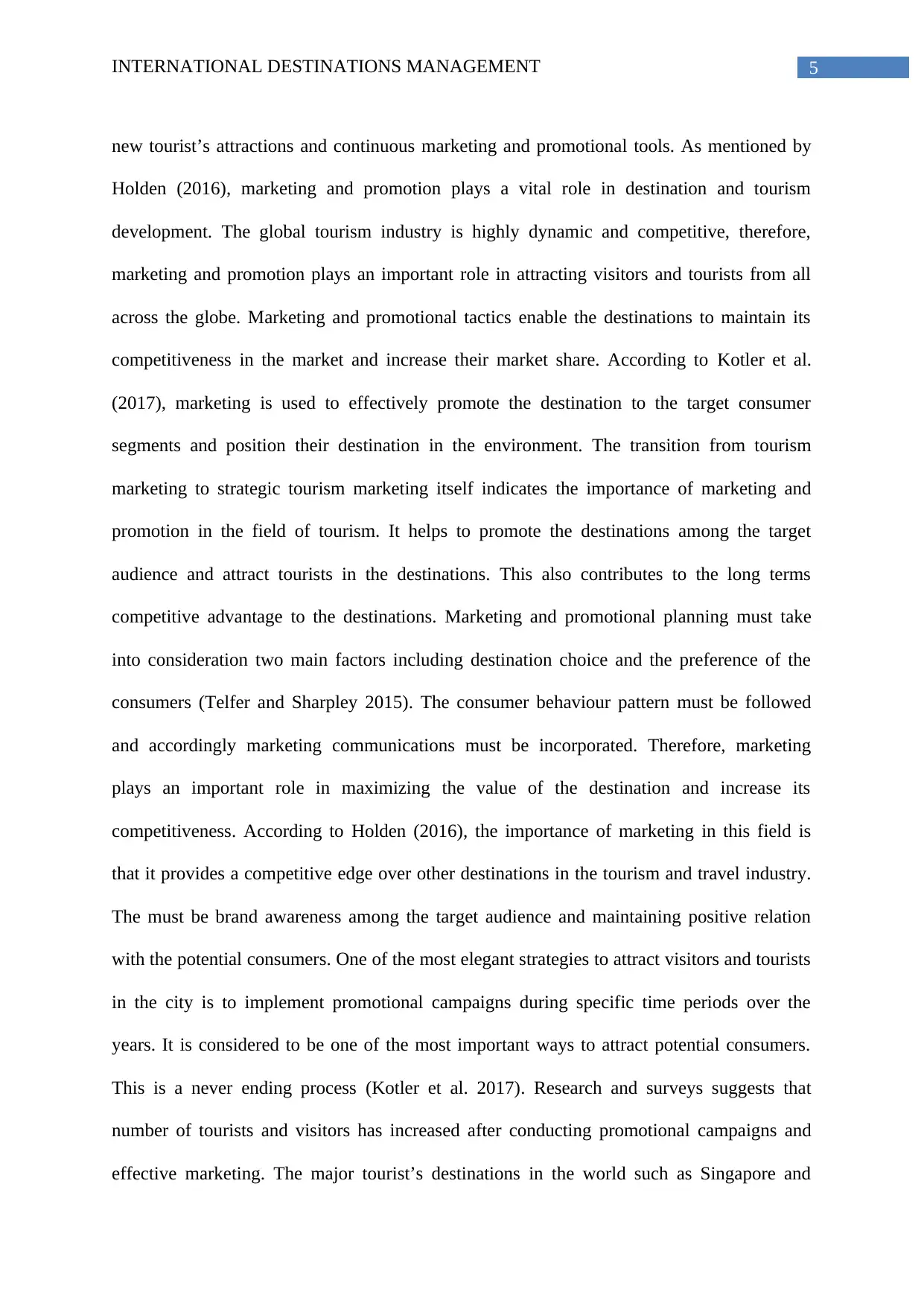
5INTERNATIONAL DESTINATIONS MANAGEMENT
new tourist’s attractions and continuous marketing and promotional tools. As mentioned by
Holden (2016), marketing and promotion plays a vital role in destination and tourism
development. The global tourism industry is highly dynamic and competitive, therefore,
marketing and promotion plays an important role in attracting visitors and tourists from all
across the globe. Marketing and promotional tactics enable the destinations to maintain its
competitiveness in the market and increase their market share. According to Kotler et al.
(2017), marketing is used to effectively promote the destination to the target consumer
segments and position their destination in the environment. The transition from tourism
marketing to strategic tourism marketing itself indicates the importance of marketing and
promotion in the field of tourism. It helps to promote the destinations among the target
audience and attract tourists in the destinations. This also contributes to the long terms
competitive advantage to the destinations. Marketing and promotional planning must take
into consideration two main factors including destination choice and the preference of the
consumers (Telfer and Sharpley 2015). The consumer behaviour pattern must be followed
and accordingly marketing communications must be incorporated. Therefore, marketing
plays an important role in maximizing the value of the destination and increase its
competitiveness. According to Holden (2016), the importance of marketing in this field is
that it provides a competitive edge over other destinations in the tourism and travel industry.
The must be brand awareness among the target audience and maintaining positive relation
with the potential consumers. One of the most elegant strategies to attract visitors and tourists
in the city is to implement promotional campaigns during specific time periods over the
years. It is considered to be one of the most important ways to attract potential consumers.
This is a never ending process (Kotler et al. 2017). Research and surveys suggests that
number of tourists and visitors has increased after conducting promotional campaigns and
effective marketing. The major tourist’s destinations in the world such as Singapore and
new tourist’s attractions and continuous marketing and promotional tools. As mentioned by
Holden (2016), marketing and promotion plays a vital role in destination and tourism
development. The global tourism industry is highly dynamic and competitive, therefore,
marketing and promotion plays an important role in attracting visitors and tourists from all
across the globe. Marketing and promotional tactics enable the destinations to maintain its
competitiveness in the market and increase their market share. According to Kotler et al.
(2017), marketing is used to effectively promote the destination to the target consumer
segments and position their destination in the environment. The transition from tourism
marketing to strategic tourism marketing itself indicates the importance of marketing and
promotion in the field of tourism. It helps to promote the destinations among the target
audience and attract tourists in the destinations. This also contributes to the long terms
competitive advantage to the destinations. Marketing and promotional planning must take
into consideration two main factors including destination choice and the preference of the
consumers (Telfer and Sharpley 2015). The consumer behaviour pattern must be followed
and accordingly marketing communications must be incorporated. Therefore, marketing
plays an important role in maximizing the value of the destination and increase its
competitiveness. According to Holden (2016), the importance of marketing in this field is
that it provides a competitive edge over other destinations in the tourism and travel industry.
The must be brand awareness among the target audience and maintaining positive relation
with the potential consumers. One of the most elegant strategies to attract visitors and tourists
in the city is to implement promotional campaigns during specific time periods over the
years. It is considered to be one of the most important ways to attract potential consumers.
This is a never ending process (Kotler et al. 2017). Research and surveys suggests that
number of tourists and visitors has increased after conducting promotional campaigns and
effective marketing. The major tourist’s destinations in the world such as Singapore and
⊘ This is a preview!⊘
Do you want full access?
Subscribe today to unlock all pages.

Trusted by 1+ million students worldwide
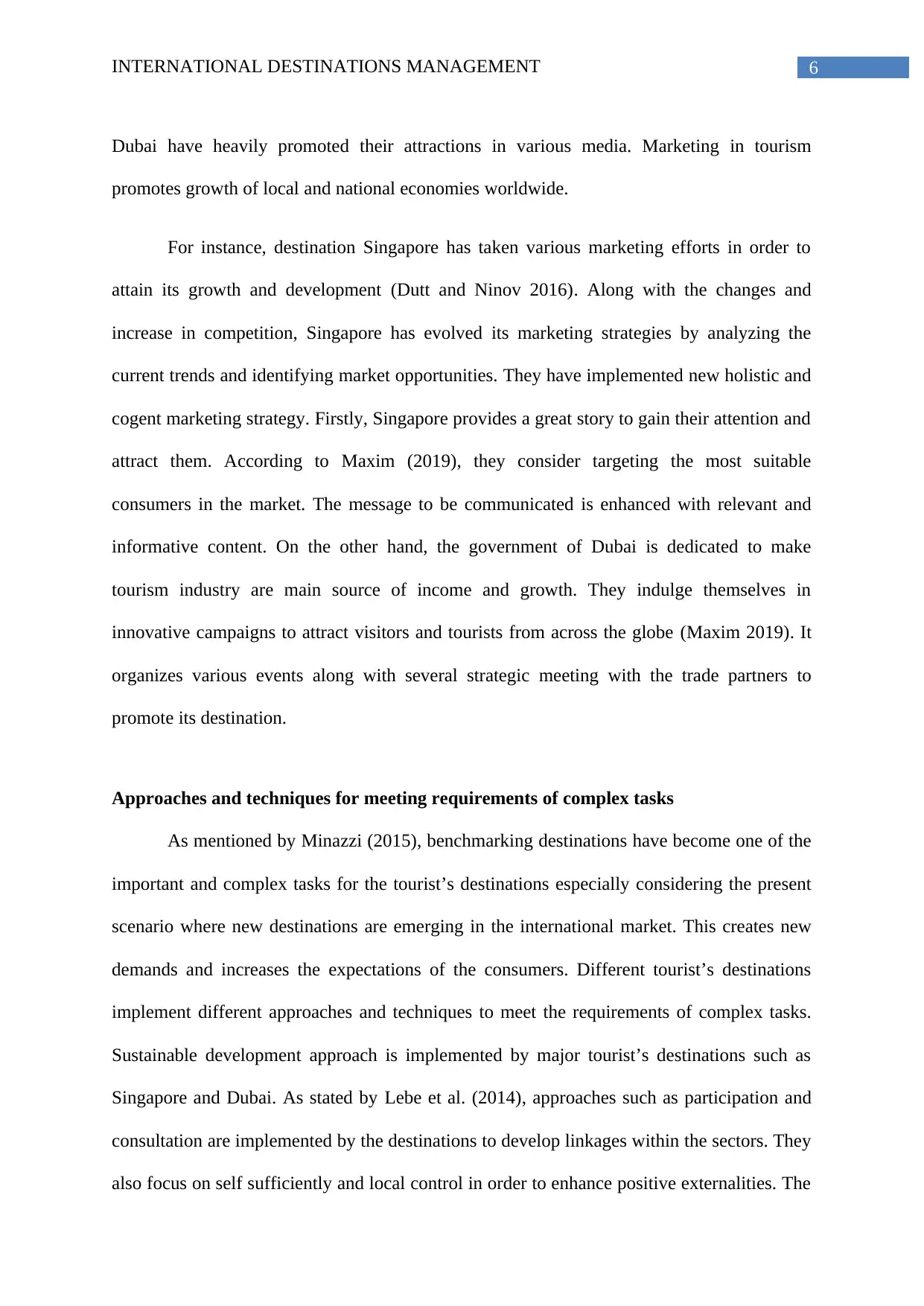
6INTERNATIONAL DESTINATIONS MANAGEMENT
Dubai have heavily promoted their attractions in various media. Marketing in tourism
promotes growth of local and national economies worldwide.
For instance, destination Singapore has taken various marketing efforts in order to
attain its growth and development (Dutt and Ninov 2016). Along with the changes and
increase in competition, Singapore has evolved its marketing strategies by analyzing the
current trends and identifying market opportunities. They have implemented new holistic and
cogent marketing strategy. Firstly, Singapore provides a great story to gain their attention and
attract them. According to Maxim (2019), they consider targeting the most suitable
consumers in the market. The message to be communicated is enhanced with relevant and
informative content. On the other hand, the government of Dubai is dedicated to make
tourism industry are main source of income and growth. They indulge themselves in
innovative campaigns to attract visitors and tourists from across the globe (Maxim 2019). It
organizes various events along with several strategic meeting with the trade partners to
promote its destination.
Approaches and techniques for meeting requirements of complex tasks
As mentioned by Minazzi (2015), benchmarking destinations have become one of the
important and complex tasks for the tourist’s destinations especially considering the present
scenario where new destinations are emerging in the international market. This creates new
demands and increases the expectations of the consumers. Different tourist’s destinations
implement different approaches and techniques to meet the requirements of complex tasks.
Sustainable development approach is implemented by major tourist’s destinations such as
Singapore and Dubai. As stated by Lebe et al. (2014), approaches such as participation and
consultation are implemented by the destinations to develop linkages within the sectors. They
also focus on self sufficiently and local control in order to enhance positive externalities. The
Dubai have heavily promoted their attractions in various media. Marketing in tourism
promotes growth of local and national economies worldwide.
For instance, destination Singapore has taken various marketing efforts in order to
attain its growth and development (Dutt and Ninov 2016). Along with the changes and
increase in competition, Singapore has evolved its marketing strategies by analyzing the
current trends and identifying market opportunities. They have implemented new holistic and
cogent marketing strategy. Firstly, Singapore provides a great story to gain their attention and
attract them. According to Maxim (2019), they consider targeting the most suitable
consumers in the market. The message to be communicated is enhanced with relevant and
informative content. On the other hand, the government of Dubai is dedicated to make
tourism industry are main source of income and growth. They indulge themselves in
innovative campaigns to attract visitors and tourists from across the globe (Maxim 2019). It
organizes various events along with several strategic meeting with the trade partners to
promote its destination.
Approaches and techniques for meeting requirements of complex tasks
As mentioned by Minazzi (2015), benchmarking destinations have become one of the
important and complex tasks for the tourist’s destinations especially considering the present
scenario where new destinations are emerging in the international market. This creates new
demands and increases the expectations of the consumers. Different tourist’s destinations
implement different approaches and techniques to meet the requirements of complex tasks.
Sustainable development approach is implemented by major tourist’s destinations such as
Singapore and Dubai. As stated by Lebe et al. (2014), approaches such as participation and
consultation are implemented by the destinations to develop linkages within the sectors. They
also focus on self sufficiently and local control in order to enhance positive externalities. The
Paraphrase This Document
Need a fresh take? Get an instant paraphrase of this document with our AI Paraphraser
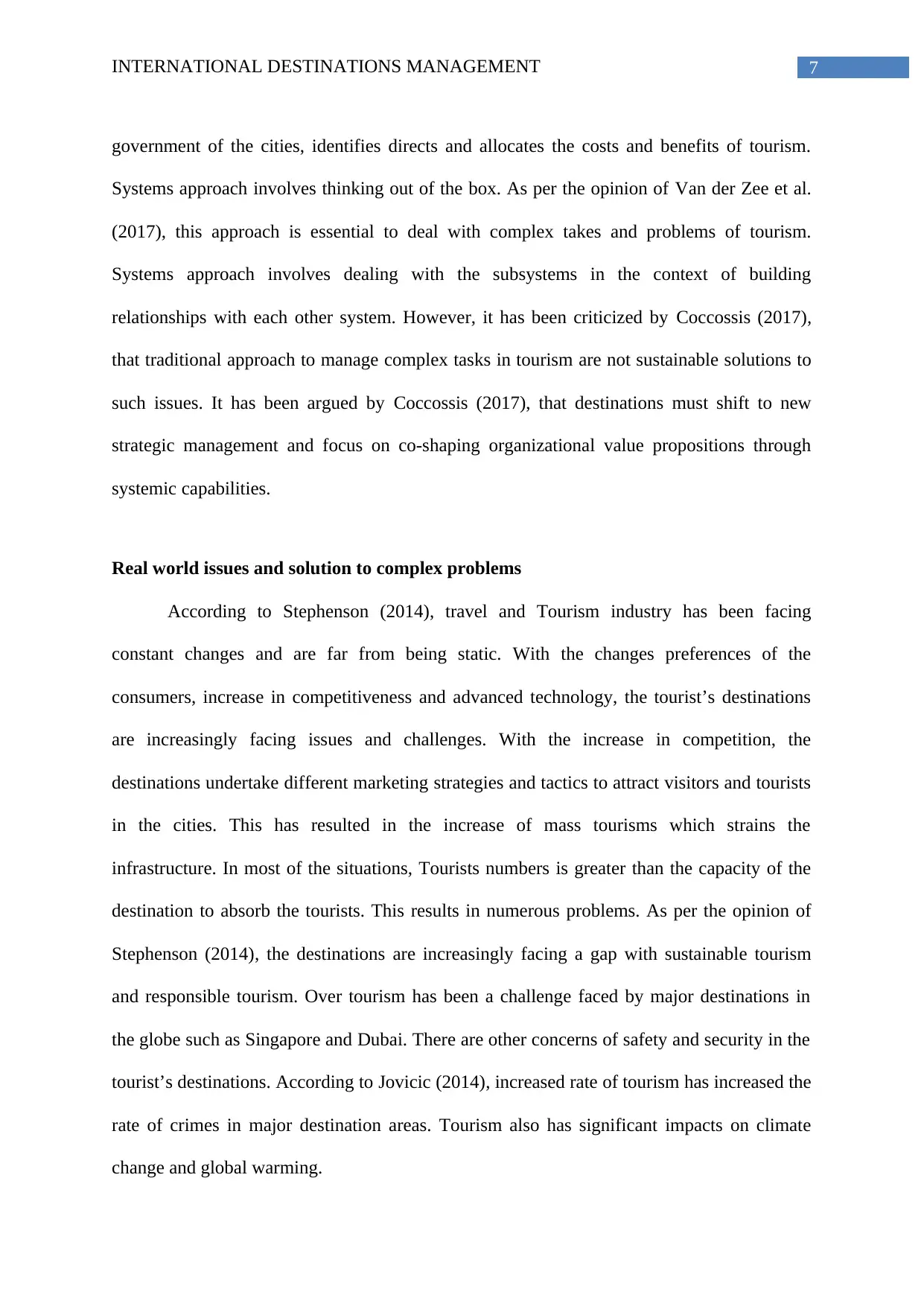
7INTERNATIONAL DESTINATIONS MANAGEMENT
government of the cities, identifies directs and allocates the costs and benefits of tourism.
Systems approach involves thinking out of the box. As per the opinion of Van der Zee et al.
(2017), this approach is essential to deal with complex takes and problems of tourism.
Systems approach involves dealing with the subsystems in the context of building
relationships with each other system. However, it has been criticized by Coccossis (2017),
that traditional approach to manage complex tasks in tourism are not sustainable solutions to
such issues. It has been argued by Coccossis (2017), that destinations must shift to new
strategic management and focus on co-shaping organizational value propositions through
systemic capabilities.
Real world issues and solution to complex problems
According to Stephenson (2014), travel and Tourism industry has been facing
constant changes and are far from being static. With the changes preferences of the
consumers, increase in competitiveness and advanced technology, the tourist’s destinations
are increasingly facing issues and challenges. With the increase in competition, the
destinations undertake different marketing strategies and tactics to attract visitors and tourists
in the cities. This has resulted in the increase of mass tourisms which strains the
infrastructure. In most of the situations, Tourists numbers is greater than the capacity of the
destination to absorb the tourists. This results in numerous problems. As per the opinion of
Stephenson (2014), the destinations are increasingly facing a gap with sustainable tourism
and responsible tourism. Over tourism has been a challenge faced by major destinations in
the globe such as Singapore and Dubai. There are other concerns of safety and security in the
tourist’s destinations. According to Jovicic (2014), increased rate of tourism has increased the
rate of crimes in major destination areas. Tourism also has significant impacts on climate
change and global warming.
government of the cities, identifies directs and allocates the costs and benefits of tourism.
Systems approach involves thinking out of the box. As per the opinion of Van der Zee et al.
(2017), this approach is essential to deal with complex takes and problems of tourism.
Systems approach involves dealing with the subsystems in the context of building
relationships with each other system. However, it has been criticized by Coccossis (2017),
that traditional approach to manage complex tasks in tourism are not sustainable solutions to
such issues. It has been argued by Coccossis (2017), that destinations must shift to new
strategic management and focus on co-shaping organizational value propositions through
systemic capabilities.
Real world issues and solution to complex problems
According to Stephenson (2014), travel and Tourism industry has been facing
constant changes and are far from being static. With the changes preferences of the
consumers, increase in competitiveness and advanced technology, the tourist’s destinations
are increasingly facing issues and challenges. With the increase in competition, the
destinations undertake different marketing strategies and tactics to attract visitors and tourists
in the cities. This has resulted in the increase of mass tourisms which strains the
infrastructure. In most of the situations, Tourists numbers is greater than the capacity of the
destination to absorb the tourists. This results in numerous problems. As per the opinion of
Stephenson (2014), the destinations are increasingly facing a gap with sustainable tourism
and responsible tourism. Over tourism has been a challenge faced by major destinations in
the globe such as Singapore and Dubai. There are other concerns of safety and security in the
tourist’s destinations. According to Jovicic (2014), increased rate of tourism has increased the
rate of crimes in major destination areas. Tourism also has significant impacts on climate
change and global warming.
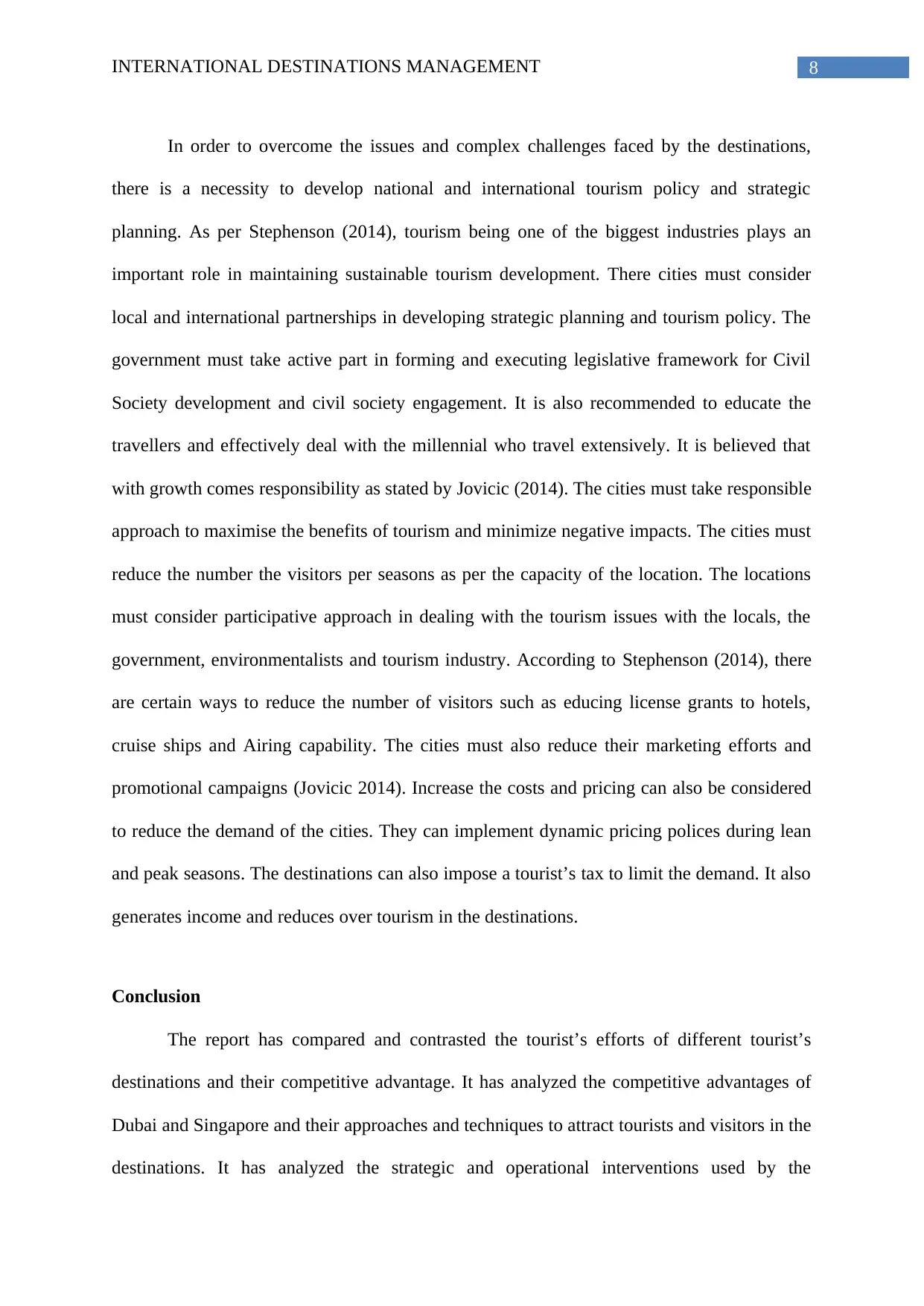
8INTERNATIONAL DESTINATIONS MANAGEMENT
In order to overcome the issues and complex challenges faced by the destinations,
there is a necessity to develop national and international tourism policy and strategic
planning. As per Stephenson (2014), tourism being one of the biggest industries plays an
important role in maintaining sustainable tourism development. There cities must consider
local and international partnerships in developing strategic planning and tourism policy. The
government must take active part in forming and executing legislative framework for Civil
Society development and civil society engagement. It is also recommended to educate the
travellers and effectively deal with the millennial who travel extensively. It is believed that
with growth comes responsibility as stated by Jovicic (2014). The cities must take responsible
approach to maximise the benefits of tourism and minimize negative impacts. The cities must
reduce the number the visitors per seasons as per the capacity of the location. The locations
must consider participative approach in dealing with the tourism issues with the locals, the
government, environmentalists and tourism industry. According to Stephenson (2014), there
are certain ways to reduce the number of visitors such as educing license grants to hotels,
cruise ships and Airing capability. The cities must also reduce their marketing efforts and
promotional campaigns (Jovicic 2014). Increase the costs and pricing can also be considered
to reduce the demand of the cities. They can implement dynamic pricing polices during lean
and peak seasons. The destinations can also impose a tourist’s tax to limit the demand. It also
generates income and reduces over tourism in the destinations.
Conclusion
The report has compared and contrasted the tourist’s efforts of different tourist’s
destinations and their competitive advantage. It has analyzed the competitive advantages of
Dubai and Singapore and their approaches and techniques to attract tourists and visitors in the
destinations. It has analyzed the strategic and operational interventions used by the
In order to overcome the issues and complex challenges faced by the destinations,
there is a necessity to develop national and international tourism policy and strategic
planning. As per Stephenson (2014), tourism being one of the biggest industries plays an
important role in maintaining sustainable tourism development. There cities must consider
local and international partnerships in developing strategic planning and tourism policy. The
government must take active part in forming and executing legislative framework for Civil
Society development and civil society engagement. It is also recommended to educate the
travellers and effectively deal with the millennial who travel extensively. It is believed that
with growth comes responsibility as stated by Jovicic (2014). The cities must take responsible
approach to maximise the benefits of tourism and minimize negative impacts. The cities must
reduce the number the visitors per seasons as per the capacity of the location. The locations
must consider participative approach in dealing with the tourism issues with the locals, the
government, environmentalists and tourism industry. According to Stephenson (2014), there
are certain ways to reduce the number of visitors such as educing license grants to hotels,
cruise ships and Airing capability. The cities must also reduce their marketing efforts and
promotional campaigns (Jovicic 2014). Increase the costs and pricing can also be considered
to reduce the demand of the cities. They can implement dynamic pricing polices during lean
and peak seasons. The destinations can also impose a tourist’s tax to limit the demand. It also
generates income and reduces over tourism in the destinations.
Conclusion
The report has compared and contrasted the tourist’s efforts of different tourist’s
destinations and their competitive advantage. It has analyzed the competitive advantages of
Dubai and Singapore and their approaches and techniques to attract tourists and visitors in the
destinations. It has analyzed the strategic and operational interventions used by the
⊘ This is a preview!⊘
Do you want full access?
Subscribe today to unlock all pages.

Trusted by 1+ million students worldwide
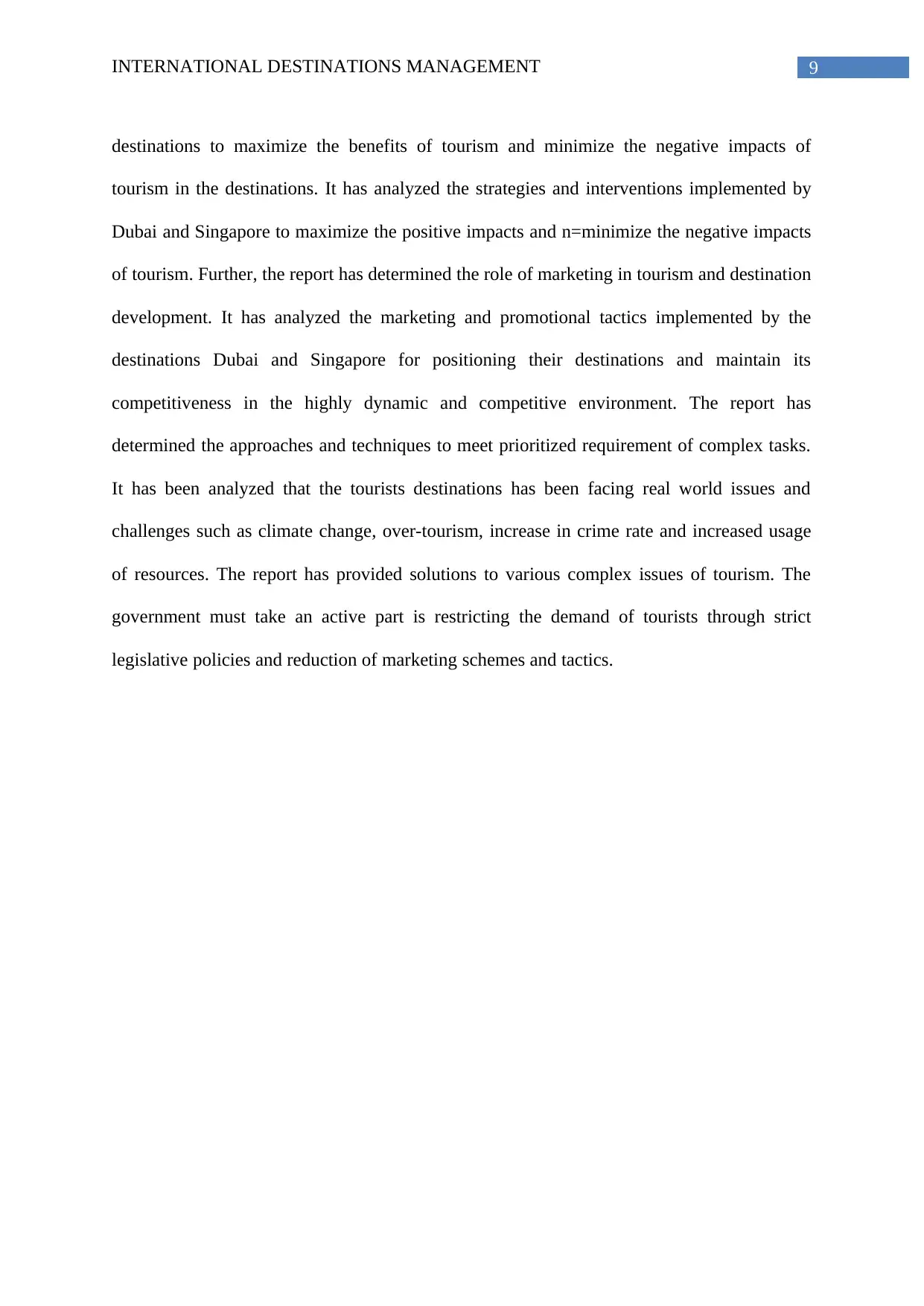
9INTERNATIONAL DESTINATIONS MANAGEMENT
destinations to maximize the benefits of tourism and minimize the negative impacts of
tourism in the destinations. It has analyzed the strategies and interventions implemented by
Dubai and Singapore to maximize the positive impacts and n=minimize the negative impacts
of tourism. Further, the report has determined the role of marketing in tourism and destination
development. It has analyzed the marketing and promotional tactics implemented by the
destinations Dubai and Singapore for positioning their destinations and maintain its
competitiveness in the highly dynamic and competitive environment. The report has
determined the approaches and techniques to meet prioritized requirement of complex tasks.
It has been analyzed that the tourists destinations has been facing real world issues and
challenges such as climate change, over-tourism, increase in crime rate and increased usage
of resources. The report has provided solutions to various complex issues of tourism. The
government must take an active part is restricting the demand of tourists through strict
legislative policies and reduction of marketing schemes and tactics.
destinations to maximize the benefits of tourism and minimize the negative impacts of
tourism in the destinations. It has analyzed the strategies and interventions implemented by
Dubai and Singapore to maximize the positive impacts and n=minimize the negative impacts
of tourism. Further, the report has determined the role of marketing in tourism and destination
development. It has analyzed the marketing and promotional tactics implemented by the
destinations Dubai and Singapore for positioning their destinations and maintain its
competitiveness in the highly dynamic and competitive environment. The report has
determined the approaches and techniques to meet prioritized requirement of complex tasks.
It has been analyzed that the tourists destinations has been facing real world issues and
challenges such as climate change, over-tourism, increase in crime rate and increased usage
of resources. The report has provided solutions to various complex issues of tourism. The
government must take an active part is restricting the demand of tourists through strict
legislative policies and reduction of marketing schemes and tactics.
Paraphrase This Document
Need a fresh take? Get an instant paraphrase of this document with our AI Paraphraser
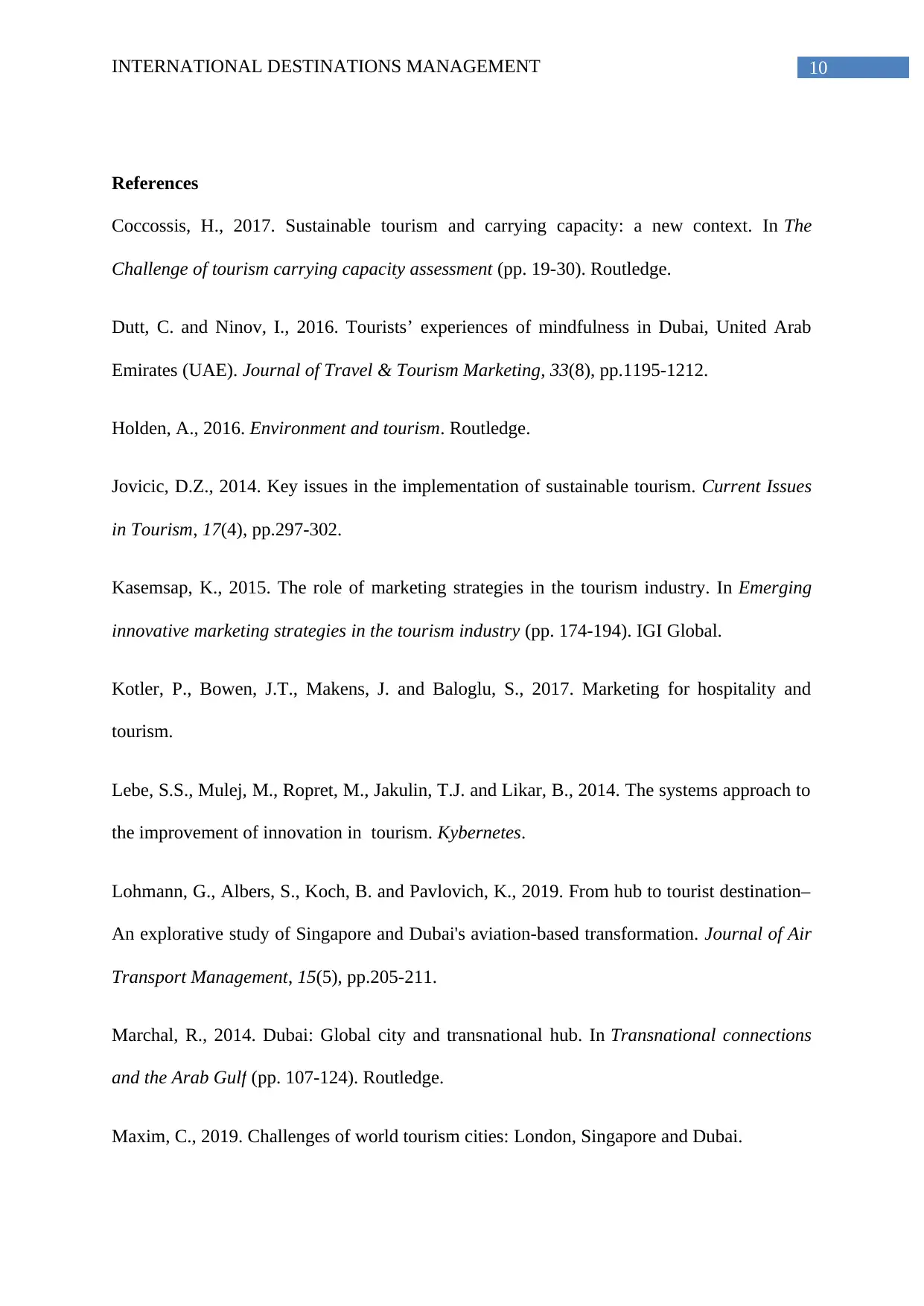
10INTERNATIONAL DESTINATIONS MANAGEMENT
References
Coccossis, H., 2017. Sustainable tourism and carrying capacity: a new context. In The
Challenge of tourism carrying capacity assessment (pp. 19-30). Routledge.
Dutt, C. and Ninov, I., 2016. Tourists’ experiences of mindfulness in Dubai, United Arab
Emirates (UAE). Journal of Travel & Tourism Marketing, 33(8), pp.1195-1212.
Holden, A., 2016. Environment and tourism. Routledge.
Jovicic, D.Z., 2014. Key issues in the implementation of sustainable tourism. Current Issues
in Tourism, 17(4), pp.297-302.
Kasemsap, K., 2015. The role of marketing strategies in the tourism industry. In Emerging
innovative marketing strategies in the tourism industry (pp. 174-194). IGI Global.
Kotler, P., Bowen, J.T., Makens, J. and Baloglu, S., 2017. Marketing for hospitality and
tourism.
Lebe, S.S., Mulej, M., Ropret, M., Jakulin, T.J. and Likar, B., 2014. The systems approach to
the improvement of innovation in tourism. Kybernetes.
Lohmann, G., Albers, S., Koch, B. and Pavlovich, K., 2019. From hub to tourist destination–
An explorative study of Singapore and Dubai's aviation-based transformation. Journal of Air
Transport Management, 15(5), pp.205-211.
Marchal, R., 2014. Dubai: Global city and transnational hub. In Transnational connections
and the Arab Gulf (pp. 107-124). Routledge.
Maxim, C., 2019. Challenges of world tourism cities: London, Singapore and Dubai.
References
Coccossis, H., 2017. Sustainable tourism and carrying capacity: a new context. In The
Challenge of tourism carrying capacity assessment (pp. 19-30). Routledge.
Dutt, C. and Ninov, I., 2016. Tourists’ experiences of mindfulness in Dubai, United Arab
Emirates (UAE). Journal of Travel & Tourism Marketing, 33(8), pp.1195-1212.
Holden, A., 2016. Environment and tourism. Routledge.
Jovicic, D.Z., 2014. Key issues in the implementation of sustainable tourism. Current Issues
in Tourism, 17(4), pp.297-302.
Kasemsap, K., 2015. The role of marketing strategies in the tourism industry. In Emerging
innovative marketing strategies in the tourism industry (pp. 174-194). IGI Global.
Kotler, P., Bowen, J.T., Makens, J. and Baloglu, S., 2017. Marketing for hospitality and
tourism.
Lebe, S.S., Mulej, M., Ropret, M., Jakulin, T.J. and Likar, B., 2014. The systems approach to
the improvement of innovation in tourism. Kybernetes.
Lohmann, G., Albers, S., Koch, B. and Pavlovich, K., 2019. From hub to tourist destination–
An explorative study of Singapore and Dubai's aviation-based transformation. Journal of Air
Transport Management, 15(5), pp.205-211.
Marchal, R., 2014. Dubai: Global city and transnational hub. In Transnational connections
and the Arab Gulf (pp. 107-124). Routledge.
Maxim, C., 2019. Challenges of world tourism cities: London, Singapore and Dubai.
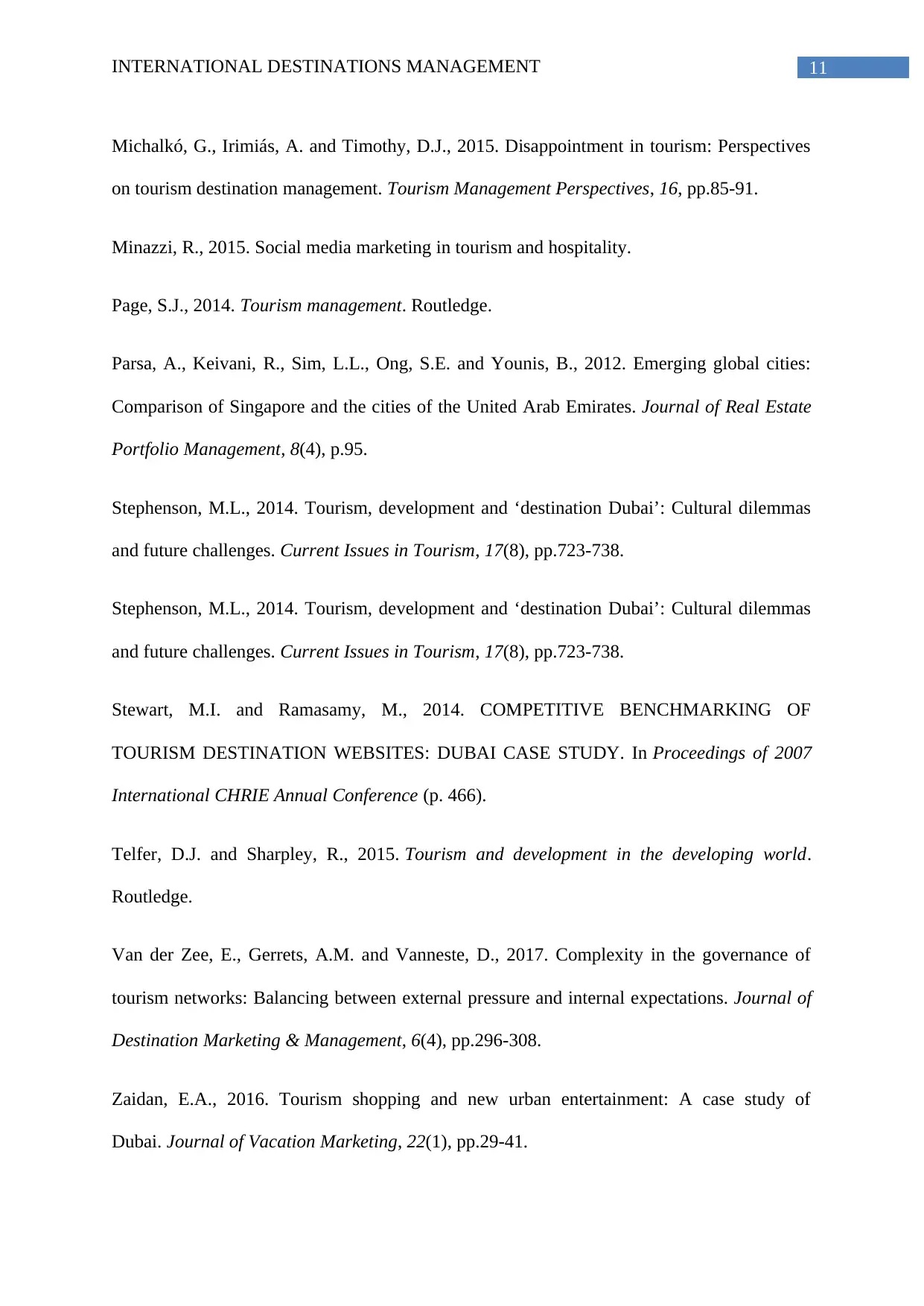
11INTERNATIONAL DESTINATIONS MANAGEMENT
Michalkó, G., Irimiás, A. and Timothy, D.J., 2015. Disappointment in tourism: Perspectives
on tourism destination management. Tourism Management Perspectives, 16, pp.85-91.
Minazzi, R., 2015. Social media marketing in tourism and hospitality.
Page, S.J., 2014. Tourism management. Routledge.
Parsa, A., Keivani, R., Sim, L.L., Ong, S.E. and Younis, B., 2012. Emerging global cities:
Comparison of Singapore and the cities of the United Arab Emirates. Journal of Real Estate
Portfolio Management, 8(4), p.95.
Stephenson, M.L., 2014. Tourism, development and ‘destination Dubai’: Cultural dilemmas
and future challenges. Current Issues in Tourism, 17(8), pp.723-738.
Stephenson, M.L., 2014. Tourism, development and ‘destination Dubai’: Cultural dilemmas
and future challenges. Current Issues in Tourism, 17(8), pp.723-738.
Stewart, M.I. and Ramasamy, M., 2014. COMPETITIVE BENCHMARKING OF
TOURISM DESTINATION WEBSITES: DUBAI CASE STUDY. In Proceedings of 2007
International CHRIE Annual Conference (p. 466).
Telfer, D.J. and Sharpley, R., 2015. Tourism and development in the developing world.
Routledge.
Van der Zee, E., Gerrets, A.M. and Vanneste, D., 2017. Complexity in the governance of
tourism networks: Balancing between external pressure and internal expectations. Journal of
Destination Marketing & Management, 6(4), pp.296-308.
Zaidan, E.A., 2016. Tourism shopping and new urban entertainment: A case study of
Dubai. Journal of Vacation Marketing, 22(1), pp.29-41.
Michalkó, G., Irimiás, A. and Timothy, D.J., 2015. Disappointment in tourism: Perspectives
on tourism destination management. Tourism Management Perspectives, 16, pp.85-91.
Minazzi, R., 2015. Social media marketing in tourism and hospitality.
Page, S.J., 2014. Tourism management. Routledge.
Parsa, A., Keivani, R., Sim, L.L., Ong, S.E. and Younis, B., 2012. Emerging global cities:
Comparison of Singapore and the cities of the United Arab Emirates. Journal of Real Estate
Portfolio Management, 8(4), p.95.
Stephenson, M.L., 2014. Tourism, development and ‘destination Dubai’: Cultural dilemmas
and future challenges. Current Issues in Tourism, 17(8), pp.723-738.
Stephenson, M.L., 2014. Tourism, development and ‘destination Dubai’: Cultural dilemmas
and future challenges. Current Issues in Tourism, 17(8), pp.723-738.
Stewart, M.I. and Ramasamy, M., 2014. COMPETITIVE BENCHMARKING OF
TOURISM DESTINATION WEBSITES: DUBAI CASE STUDY. In Proceedings of 2007
International CHRIE Annual Conference (p. 466).
Telfer, D.J. and Sharpley, R., 2015. Tourism and development in the developing world.
Routledge.
Van der Zee, E., Gerrets, A.M. and Vanneste, D., 2017. Complexity in the governance of
tourism networks: Balancing between external pressure and internal expectations. Journal of
Destination Marketing & Management, 6(4), pp.296-308.
Zaidan, E.A., 2016. Tourism shopping and new urban entertainment: A case study of
Dubai. Journal of Vacation Marketing, 22(1), pp.29-41.
⊘ This is a preview!⊘
Do you want full access?
Subscribe today to unlock all pages.

Trusted by 1+ million students worldwide
1 out of 13
Related Documents
Your All-in-One AI-Powered Toolkit for Academic Success.
+13062052269
info@desklib.com
Available 24*7 on WhatsApp / Email
![[object Object]](/_next/static/media/star-bottom.7253800d.svg)
Unlock your academic potential
Copyright © 2020–2025 A2Z Services. All Rights Reserved. Developed and managed by ZUCOL.



